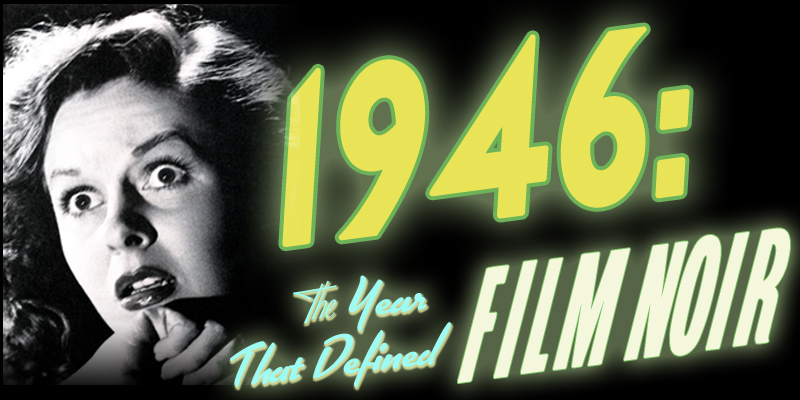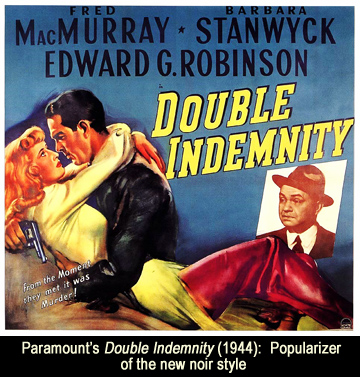
NOIR LINKS
10 Shades Of Noir
Back Alley Noir
Classic Noir Online
Dr. Noir's Crime Posters
AMC Film Noir
Film Noir Foundation
The Dark Room
Noir of the Week
Noircast.net
Film Noir Alley
Noir City
IMDb
As a cycle or even a genre of American film, the film noir is commonly considered to have had its genesis in the early 1940s, although scattered precursors
have been identified as far back as the 1920s and the silent film era. First coined by French cineastes in response to a flood of crime films that saw their
first exhibitions in France in the immediate wake of World War Two, the term film noir - literally, "black film" - has acquired a host of expansive meanings in the
ensuing years.
 Perhaps one of the more evocative definitions of the noir style is that given by Francis Nevins, the biographer of one of film noir's literary godfathers, Cornell Woolrich.
The noir style, Nevins wrote, is a kind of "bleak, disillusioned study in the poetry of terror," characterized by elements such as "fear, guilt and loneliness,
breakdown and despair, sexual obsession and social corruption, a sense that the world is controlled by malignant forces preying on us, a rejection of
happy endings, and a preference for resolutions heavy with dooom, but always redeemed by a breathtakingly vivid poetry of image."
Perhaps one of the more evocative definitions of the noir style is that given by Francis Nevins, the biographer of one of film noir's literary godfathers, Cornell Woolrich.
The noir style, Nevins wrote, is a kind of "bleak, disillusioned study in the poetry of terror," characterized by elements such as "fear, guilt and loneliness,
breakdown and despair, sexual obsession and social corruption, a sense that the world is controlled by malignant forces preying on us, a rejection of
happy endings, and a preference for resolutions heavy with dooom, but always redeemed by a breathtakingly vivid poetry of image."
There were numerous films of this type through the first half of the 1940s, some of them hallmarks of the cycle such as The Maltese Falcon (1941),
This Gun for Hire (1942), Murder, My Sweet and Double Indemnity, both from 1944, and Mildred Pierce (1945).
But beginning in 1946, productions of this type of crime film began mushrooming. A hunger for product examining the dark underbelly of society became
common across all major Hollywood studios, even though some, like RKO and Columbia, were more renowned for their noir films than others.
What accounted for this relatively sudden explosion of popularity for the film noir? It's probably impossible to account for all of the factors behind
film noir's rise in the immediate post-war era, although several main influences immediately spring to mind:
 As the war was drawing to a close, commentators were already beginning to remark on the growing Hollywood appetite for darker-themed crime and murder
mysteries. A New York Times article from 1945 opined that one key reason for the growing number of noir-like Hollywood product was that studio
executives were taken aback by the box-office success of Paramount's Double Indemnity the previous year, and that "the current crop of hard-boiled, action-packed
cinema murders is the time-honored Hollywood production formula of follow-the-leader. Let one studio turn out a successful detective story picture and every
other studio in the screen capital follows suit. Result: a surfeit of motion pictures of one type."
As the war was drawing to a close, commentators were already beginning to remark on the growing Hollywood appetite for darker-themed crime and murder
mysteries. A New York Times article from 1945 opined that one key reason for the growing number of noir-like Hollywood product was that studio
executives were taken aback by the box-office success of Paramount's Double Indemnity the previous year, and that "the current crop of hard-boiled, action-packed
cinema murders is the time-honored Hollywood production formula of follow-the-leader. Let one studio turn out a successful detective story picture and every
other studio in the screen capital follows suit. Result: a surfeit of motion pictures of one type."
This site begins with the examination of four key film noirs released in 1946: The Blue Dahlia, The Chase, Somewhere In The Night, and The Stranger. As time
permits, it is hoped that the list of detailed treatments can be gradually expanded, so that all of these lost films will receive the renewed attention they so richly deserve.
TITLE |
DIRECTOR |
STUDIO |
| The Big Sleep | Howard Hawks | Warner Brothers |
| Black Angel | Roy William Neill | Universal |
| The Blue Dahlia | George Marshall | Paramount |
| The Chase | Arthur Ripley | United Artists |
| Crack-Up | Irving Reis | RKO |
| The Dark Corner | Henry Hathaway | 20th Century Fox |
| The Dark Mirror | Robert Siodmak | Universal |
| Deadline At Dawn | Harold Clurman | RKO |
| Decoy | Jack Bernhard | Monogram |
| Fallen Angel | Otto Preminger | 20th Century Fox |
| Fear | Alfred Zeisler | Monogram |
| Gilda | Charles Vidor | Columbia |
| The Killers | Robert Siodmak | Universal |
| Night Editor | Henry Levin | Columbia |
| Nobody Lives Forever | Jean Negulesco | Warner Brothers |
| Nocturne | Edwin L. Marin | RKO |
| Notorious | Alfred Hitchcock | RKO |
| The Postman Always Rings Twice | Tay Garnett | MGM |
| So Dark The Night | Joseph H. Lewis | Columbia |
| Somewhere In The Night | Joseph L. Mankiewicz | 20th Century Fox |
| The Strange Love Of Martha Ivers | Lewis Milestone | Paramount |
| The Stranger | Orson Welles | RKO |
| Suspense | Frank Tuttle | Monogram |
| Undercurrent | Vincente Minelli | MGM |